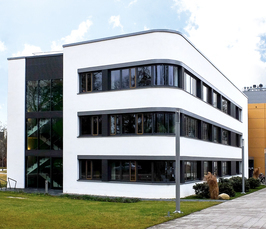The first part of my talk will focus on ultrafast two-dimensional infrared (2DIR) and transient infrared (TRIR) spectroscopic studies of formamidinium lead iodide perovskite films. High absorption coefficients, high carrier mobilities, and low charge recombination rates, despite low-cost solution-phase synthesis,
1 have led to intense research into hybrid organic-inorganic halide perovskites for photovoltaic applications. Hybrid organic-inorganic halide perovskites consist of organic cations caged within an inorganic lattice of metal and halogen atoms. Several studies have proposed that the organic cations play a pivotal role in the high charge separation efficiencies of these materials
2 by orientating within the inorganic lattice to form (anti)ferroelectric domains at room temperature.
3 It has been proposed that these domains act to channel opposite charges away from one another, thereby reducing charge recombination. 2DIR anisotropy measurements were used to interrogate the reorientation of formamidinium cations (FA
+, NH
2CHNH
2+) in formamidinium lead iodide perovskite films. These rotational anisotropy measurements returned 470 ± 50 fs and 2.8 ± 0.5 ps time constants, meaning that any initial alignment of FA
+ molecules is very short lived, casting significant doubt on the presence of long-lived (anti)ferroelectric domains.
4 TRIR measurements revealed a prominent vibrational transient feature arising from a vibrational Stark shift: photogenerated charge carriers increase the internal electric field of perovskite thin films, perturbing the FA
+ antisymmetric stretching vibrational potential, resulting in an observed 5 cm
–1 shift. This observation suggests the formation of large polarons, which may explain the observed long charge-carrier lifetimes despite inhomogeneous microscopic morphologies. In the second part of this talk I will present data from recent ultrafast transient absorption studies of J-aggregate-hollow gold nanoshells hybrids. These hybrid structures allow for the exploration of coupling between excitons (J-aggregates) and localised surface plasmon resonances (LSPR) on gold nanoparticles.
5 Through my wavelength dependent studies of various samples, I have revealed that the coupling between the exciton and plasmon resonance is faster than my instrument response (25 fs) and the ‘true’ transient spectrum of the hybrid particle. (1) Wright, A. D.; Verdi, C.; Milot, R. L.; Eperon, G. E.; rez-Osorio, M. A. P. E.; Snaith, H. J.; Giustino, F.; Johnston, M. B.; Herz, L. M. Electron-Phonon Coupling in Hybrid Lead Halide Perovskites.
Nat. Commun. 2016,
7, 1–9. (2) Gélvez-Rueda, M. C.; Cao, D. H.; Patwardhan, S.; Renaud, N.; Stoumpos, C. C.; Schatz, G. C.; Hupp, J. T.; Farha, O. K.; Savenije, T. J.; Kanatzidis, M. G.; et al. Effect of Cation Rotation on Charge Dynamics in Hybrid Lead Halide Perovskites.
J. Phys. Chem. C 2016,
120 (30), 16577–16585. (3) Frost, J. M.; Butler, K. T.; Brivio, F.; Hendon, C. H.; van Schilfgaarde, M.; Walsh, A. Atomistic Origins of High-Performance in Hybrid Halide Perovskite Solar Cells.
Nano Lett. 2014,
14 (5), 2584–2590. (4) Taylor, V. C. A.; Tiwari, D.; Duchi, M.; Donaldson, P. M.; Clark, I. P.; Fermin, D. J.; Oliver, T. A. A. Investigating the Role of the Organic Cation in Formamidinium Lead Iodide Perovskite Using Ultrafast Spectroscopy.
J. Phys. Chem. Lett. 2018,
9 (4), 895–901. (5) Faucheaux, J. A.; Fu, J.; Jain, P. K. Unified Theoretical Framework for Realizing Diverse Regimes of Strong Coupling Between Plasmons and Electronic Transitions.
J. Phys. Chem. C 2014,
118 (5), 2710–2717.
[more]

